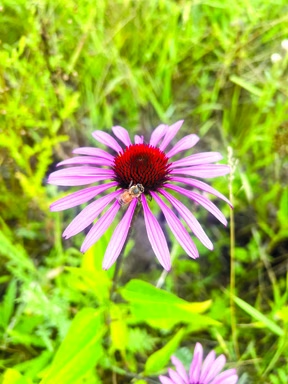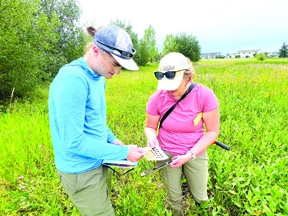
At Minot Air Force Base in North Dakota, a collaborative environmental effort has been underway to restore native ecosystems, manage stormwater infrastructure, and protect pollinator populations through the revitalization of wetlands and prairie lands. Restoration of the area began in fall 2023, when native seeds were planted and left to overwinter, a natural process known as cold stratification, which allowed them to germinate and sprout in spring 2024. With over 150 species of wildflowers recorded, and more being discovered, this project is both a scientific undertaking and a testament to the power of land stewardship, an inspiring reminder that the quiet beauty of Minot AFB and North Dakota thrives even in the most unexpected places.
The prairie restoration efforts are diverse and timed for long-term success. According to Lynda LaFond, Many of the seeded plants are perennials or biennials that may take several years to fully establish. The site features native grasses like bunchgrass, which provide vital winter habitat for insects, along with colorful blooms such as black-eyed Susans, blanket flowers, upright coneflowers, and multiple types of milkweed.
“We want food sources for pollinators across the whole season,” says Lynda LaFond, Natural and Cultural Resource Program Manager for the 5th Civil Engineering Squadron at Minot AFB. “From early spring species like prairie smoke to late-season asters and goldenrods, each plant plays a role.”One of the simplest, yet most impactful contributions to the local ecosystem comes from collecting milkweed seeds, vital for monarch butterflies. During peak season they can gather enough seeds to fill a gallon-sized bag, which are then scattered across Minot AFB and surrounding areas to support pollinators and native plant growth.
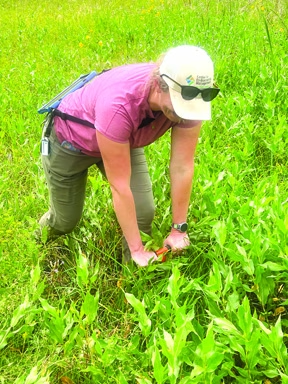
Occasionally the base conducts controlled burns in collaboration with the Minot AFB Fire Department to regenerate soils and promote native vegetation. In another partnership, the National Wild Turkey Federation donated over 500 non-fruit trees and helped construct wildlife camera booths, used to capture images of foxes, long-tailed weasels, and other species that quietly roam the base.
Minot’s Outdoor Wildlife Learning Center, located just beyond base housing and near North Plains Elementary, has become a refuge for wildlife and an outdoor classroom for community members. “There are walking trails, birdhouses, and cold-camping sites, no fires, no restrooms, just a natural space to connect with nature,” explains LaFond. The area was developed with help from Eagle Scouts and can be used by homeschooling organizations and school groups to study wildlife, habitats, and biodiversity.
A camera booth, baited with seeds, even passively samples small wildlife populations. “It gives us insight into the micro-fauna, mice, ground squirrels, without disturbing them,” says LaFond.
Samantha Bietsch and Colin Gaughan, Vegetation Mapping Specialists and Wetland Delineators with Colorado State University’s Center for Environmental Management of Military Lands (CEMML), are conducting a comprehensive wetland inventory at Minot AFB.
According to Bietsch, an area must meet three criteria to be classified as a wetland: evidence of water (hydrology), the presence of wetland vegetation, and specific soil characteristics such as reduced iron, indicated by red mottling due to low oxygen conditions.
“Some wetlands are seasonal and only appear during spring runoff or snowmelt,” says Bietsch. These wetlands play a crucial role, especially in drought-prone areas like North Dakota, where they retain meltwater, filter pollutants, and provide breeding grounds for amphibians and aquatic insects.
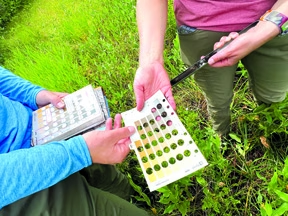
The CSU team uses GPS and geospatial mapping tools to build detailed wetland and vegetation layers. This data aids stormwater management, planning for climate resilience, and modeling flood plains, particularly in flood-prone areas like Bud Ebert Park.
“We’ve found wetlands that didn’t appear on previous maps,” says Gaughan. “Wetlands are dynamic systems. Changes in surface water flow and even crust rebound from post-glacial shifts mean they can appear or disappear over time.”
Another major focus is reducing unnecessary mowing in residential areas of the base to support wildlife. Taller grass deters Richardson’s Ground Squirrels, which prefer open, trimmed environments to detect predators. Allowing native plants and grasses to thrive not only discourages these pests but also enhances pollinator habitat and reduces maintenance costs.
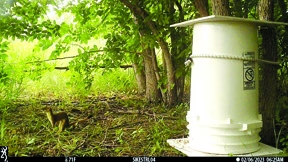
=
LaFond emphasizes that while trees are being added to certain areas, Minot AFB exists within a mixed-grass prairie ecosystem, not a forest. “We are in a rain shadow from the Rockies. This is not naturally a tree-dense region,” she says. “Restoring native prairie, grasses and forbs, is key.”
Beyond the environmental impacts, the restoration work at Minot AFB has social and educational benefits. Students, scouts, and families can now explore natural spaces right next to base housing. Walking paths connect to local schools, and natural spaces promote physical and mental well-being for residents.
“Being outside has benefits not just for wildlife but for human health,” says LaFond. “It decreases stress, helps us reconnect with the environment, and reminds us of our place in the ecosystem.”
With the help of biologists, vegetation specialists, student volunteers, and military personnel, the base is not only preserving its natural heritage but setting an example for sustainable land use across the military landscape.

